
Learning SEO copywriting was a game-changer for me. It combines two powerful skills: search engine optimization and persuasive writing.
If you only know one, it’s like leaving a delicious piece of French toast on your plate – you’re missing out on big opportunities.
Whether you’re an SEO consultant, content writer, or agency owner, mastering SEO copywriting is essential.
First, let’s cover the basics of SEO in content marketing. You need to pick a keyword to attract the right visitors and optimize your post for that keyword.
But that’s just the start. Your content must be high-quality and useful to impress readers.
Your blog post needs to be the best resource on the topic. When it is, people are more likely to read, share, link, and buy from you (or recommend you to others).
Remember, the goal isn’t just to get more traffic. It’s to get someone to take action.
What Is SEO Copywriting?
I leverage SEO and UX to grow sales, and that’s the same mindset I’d like you to adopt to beat your competition.
SEO copywriting can be thought of as a sales machine that makes both site visitors and Google happy. When you know how to effectively tell search engines what your content is about, and also provide the most engaging and thorough experience for a website visitor, it’s an SEO win-win.
And that win-win directly translates into interested prospects loving your site and becoming a customer or client.
Clearly, this process takes some technical and creative chops, but I’ve got you covered with 11 steps that will help you produce content for SEO that:
- Targets a specific keyword
- Stands out with a compelling angle
- Solves a problem or fulfills a desire
- Establishes your website as a useful resource
- Promotes social sharing and gaining backlinks
If you work in a highly competitive niche, you’ll especially appreciate this thoughtful and logical content marketing method.
But first, what does French toast have to do with this?
SEO for Copywriters
Copywriters should know how SEO works because if people don’t find their content, it’s a waste of persuasive writing.
For example, I love French toast, so let’s pretend you’re a writer working on content for a family-run business called Green Mountain Family Farms.
Green Mountain Family Farms makes and sells small batch, organic maple syrup from the forest in Vermont. The product is called Organic Maple One-Up.
The right customers for Organic Maple One-Up care about quality and want to support small businesses. At some point, you’ll naturally need to write a blog post about the best French toast recipe to complement Organic Maple One-Up.
If you’re a skilled copywriter, you might write a great recipe that seamlessly guides the reader to share the blog post and/or purchase Organic Maple One-Up …
But if you have no knowledge of SEO and keyword optimization to support your blog post, other French toast recipes will rank higher in search engines and get more traffic.
So even though you’ve got a great product on your hand, and a superior French toast recipe, interested prospects will land on other sites, share other recipes, and contribute to the sales of other maple syrups.
Kind of a copywriting fail.
How to Write SEO Content
At this point, it’s a no-brainer. Copywriting and SEO go hand in hand. You definitely want to build original, irresistible, and persuasive blog posts around SEO that meets Google’s E-E-A-T and YMYL guidelines.
The ingredients for that type of content include keyword research, headline writing with optimized H1 tags, and storytelling, as well as fast-loading visuals that enhance your content and calls to action at the exact right moments.
The 11 steps below will also help streamline your content creation process, so that you always produce easy-to-read and effective articles.
Step #1: Pick a Target Keyword
A lot of people start off using Google Keyword Planner, but just like I mentioned in my Semrush review, if you’re serious about growing your SEO skills, you’ll want to invest in more comprehensive keyword research tools.
I’ll be using Semrush’s Keyword Research tool for the examples below.
The word or phrase you select will be based on:
- What people search for
- Keyword difficulty
- Your ability to create content that fills a gap in the marketplace
For that last bullet point, spoiler: it really helps if you know SEO copywriting.
In the screenshot below from Semrush’s Keyword Overview tool, you’ll see “best french toast recipe” has a pretty high search volume and a lot of competition.
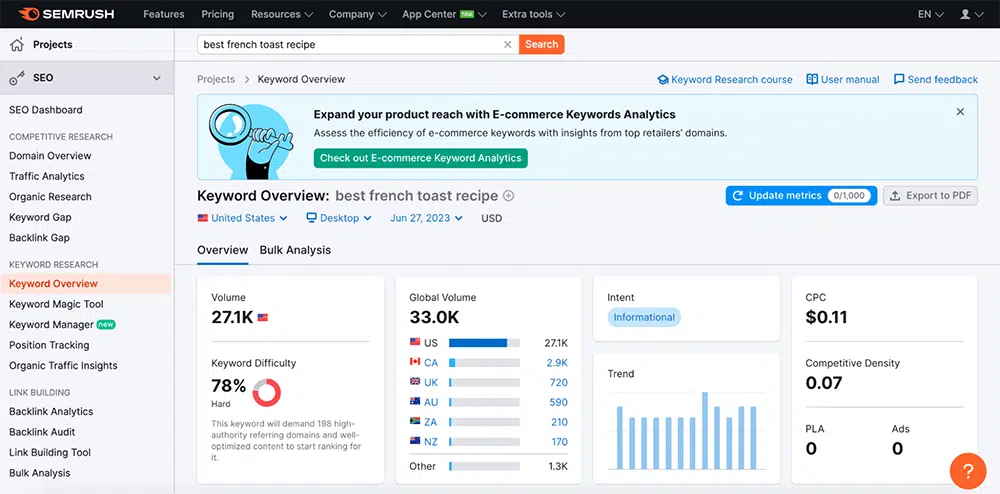
You might want to write your article around “french toast with maple syrup” for a better chance of ranking. The search volume is much lower, but it’s more closely related to what you sell and there’s less competition.
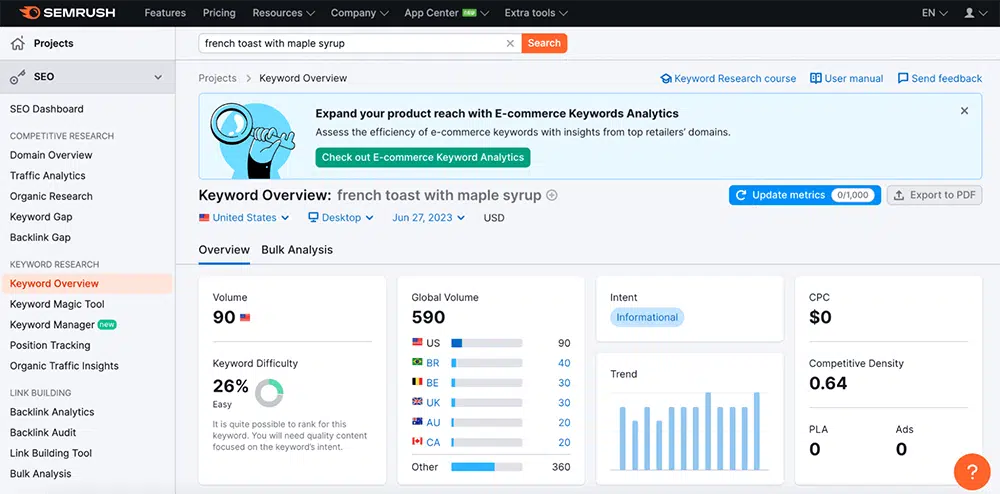
We’ll expand on our keyword possibilities when we get into headline writing.
Step #2: Review the SERP for the Content That Currently Ranks
Let’s say you decided to go with “french toast with maple syrup” for your keyword phrase.
Do you have to guess about where to start?
Of course not. Check out the top of the search engine results page (SERP) for that term.
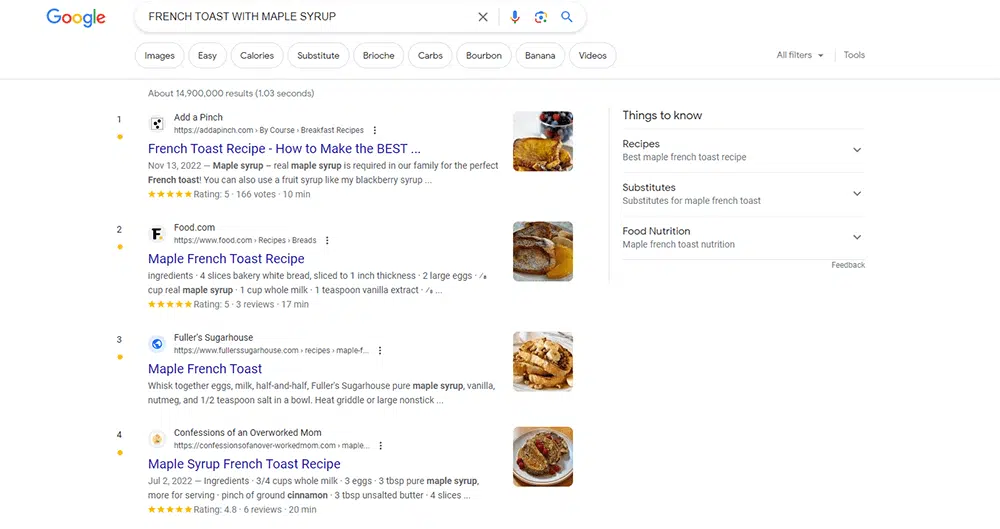
Review what Google recognizes as the best content, and then it’s your job to do it better.
When you have an outstanding product to sell and SEO copywriting skills, you’re on your way.
Think about how you can make your article:
- Easier to read
- More relevant for interested readers
- Fun to share
People share content that makes them look smart, so create an article that someone would love to boast about finding to their friends.
Step #3: Identify the Search Intent
Your article’s format and tone should match what a person needs to satisfy their search.
That’s where search intent comes into play, and there are four main types:
- Informational search intent
- Navigational search intent
- Commercial search intent
- Transactional search intent
“French toast with maple syrup” is an informational search because someone wants to find out more about the topic.
Here are some examples of other types of search intent:
- “Login page for The French Toast Fan Club” (navigational)
- “French toast near me” (commercial)
- “Order French toast” (transactional)
You’ll shape your content around the searcher’s intention in order to show that your article is the best and most closely related to the search. It should be clear that your article will be helpful and worth the reader’s time.
Step #4: Put a Long-tail Keyword in Your Headline and Title Tag
So how do you immediately capture attention?
The title tag and headline of your article.
It’s time to get creative. You’ll review the content that already ranks for your keyword phrase and craft an even better headline.
The goal is to immediately let searchers know that your article is relevant to what they’re looking for and is the best fit for their needs.
Here’s where we can add on to our original keyword phrase to also include long-tail keywords.
If you chose “french toast with maple syrup” for your keyword phrase, you could add “how to” and “best” to both your title tag and headline: “How to Make the Best French Toast with Maple Syrup.”
Long-tail keywords help you rank for different keyword phrases, in addition to the original one you chose to go after.
- Your original keyword phrase: “french toast with maple syrup”
- Headline now also includes keyword phrases: “best french toast,” “how to make the best french toast”
Here’s the Keyword Overview results for “best french toast:”
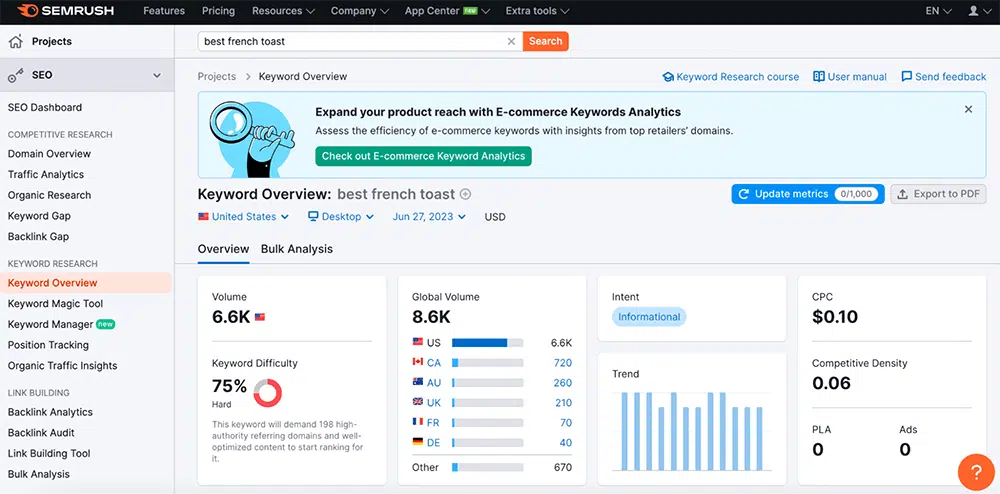
And here’s the Keyword Overview results for “how to make the best french toast”:
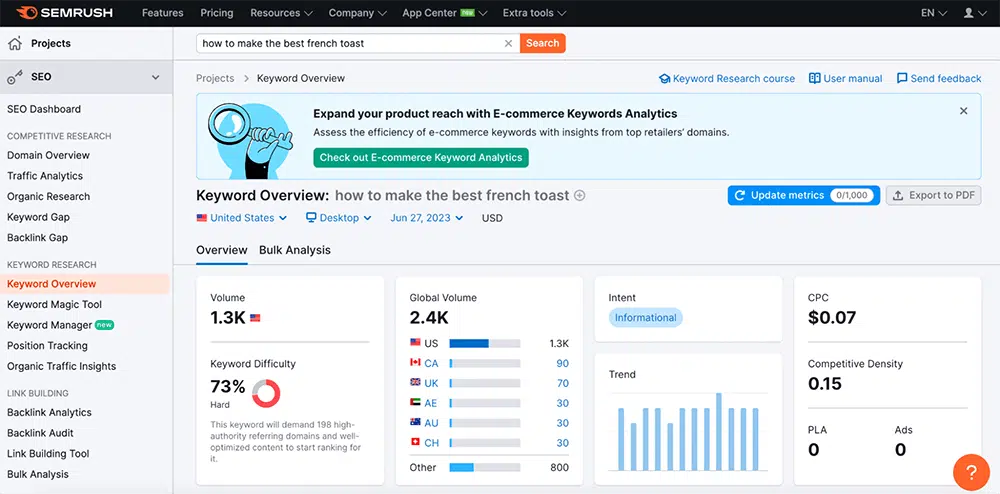
Since “how to make the best french toast with maple syrup” is an accurate summary of your content, you’ll want to put that entire keyword phrase in your meta description too.
Great SEO copywriting looks for opportunities to first bring more of the right prospects to your site, convince them you’ve got something special going on, and eventually turn them into customers.
Step #5: Take a Holistic Approach
Your website should be easy to navigate, technically sound, and secure. This is the foundation for a blog that has a chance of becoming the best resource in a certain niche.
Since you want people to naturally link to your blog posts, it’s important to remember that each post you write is part of your broader content marketing and even SEO strategy.
In order to compete with top websites in your space, you might want to take a look at the most linkable resources on your topic. To do this, you can use Semrush’s Backlink Analytics to both perform a backlink audit of your own site and check out the sites that have outbound links to your competitors.
For example, a competitor of our fictional Green Mountain Family Farms might be the real company Coombs Family Farms.

With the information below at your disposal, you can start crafting the type of content that visitors want and add new aspects that make the website for Green Mountain Family Farms an authority as well.
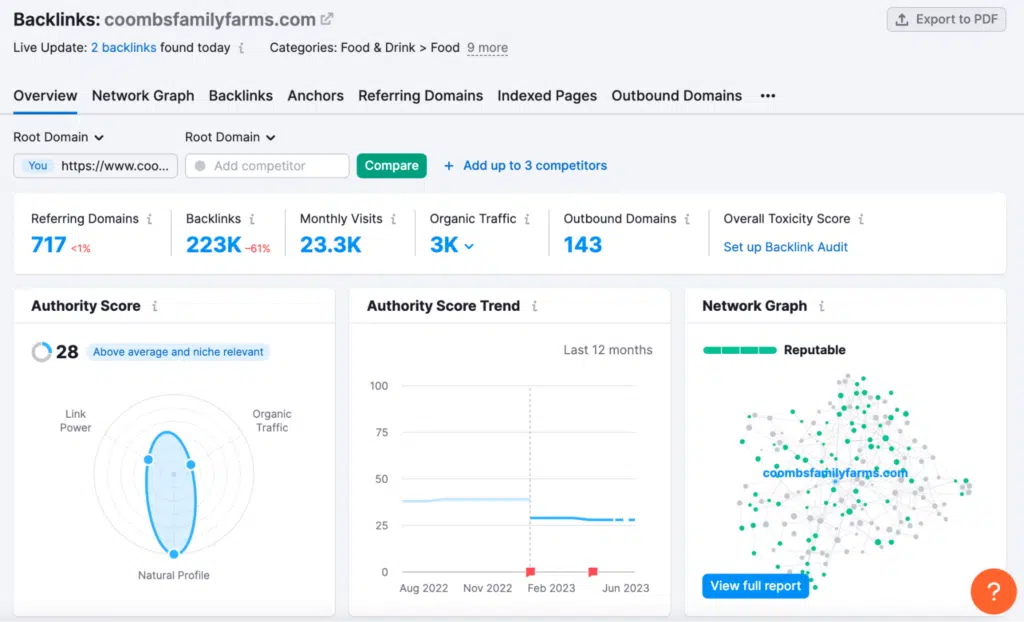
As you can see, effective SEO copywriting involves detailed research and requires outstanding writing skills.
Step #6: Format Easy-to-Read Text
The best copywriters don’t over-complicate their blog posts. They know to outline their content before they begin writing copy or content, follow internal linking best practices, and set a logical structure for their reader.
Easy-to-read text is essential for SEO copywriting because it helps:
- Eliminate overwhelm (reducing bounce rate)
- Draw readers into each section
- Highlight your most important points
Confusing content reduces your ability to convert visitors into customers. Take a look at this quote from art director George Lois:
“All creativity should communicate in a nanosecond.”
– George LoisWhen you’re formatting your blog post, keep your audience’s needs in mind.
- What do they need to know first?
- Do they prefer short paragraphs or long paragraphs?
- Is this content an accurate representation of your brand?
- Why should they choose this post over others like it?
- Which words will keep them engaged?
Semrush’s SEO Content Checker can help you out with all of that, as well as general readability and plagiarism checks. Nice.
Step #7: Mention Semantically Related Keywords
Let’s look at traditional magazine article writing to understand the importance of semantically related keywords that you’ll want to use in your blog posts.
A magazine is going to cover a general subject, such as art, cars, or snowboarding.
Individual magazine articles are going to cover topics for people interested in a certain subject.
Similarly, your blog is going to cover a general subject, and individual blog posts are going to cover topics for people interested in a certain subject.
Every individual magazine article or blog post isn’t just going to repeat the same words. They’re going to tell relevant stories with varied language.
First, think about which semantically related keywords make sense for your blog post:
- How will your ideal reader find your blog post?
- What else would this reader like to know that’s related to their search?
- Could your post have subheadings that make it unique?
Keyword ideas that you discover in Semrush might inform your choices.
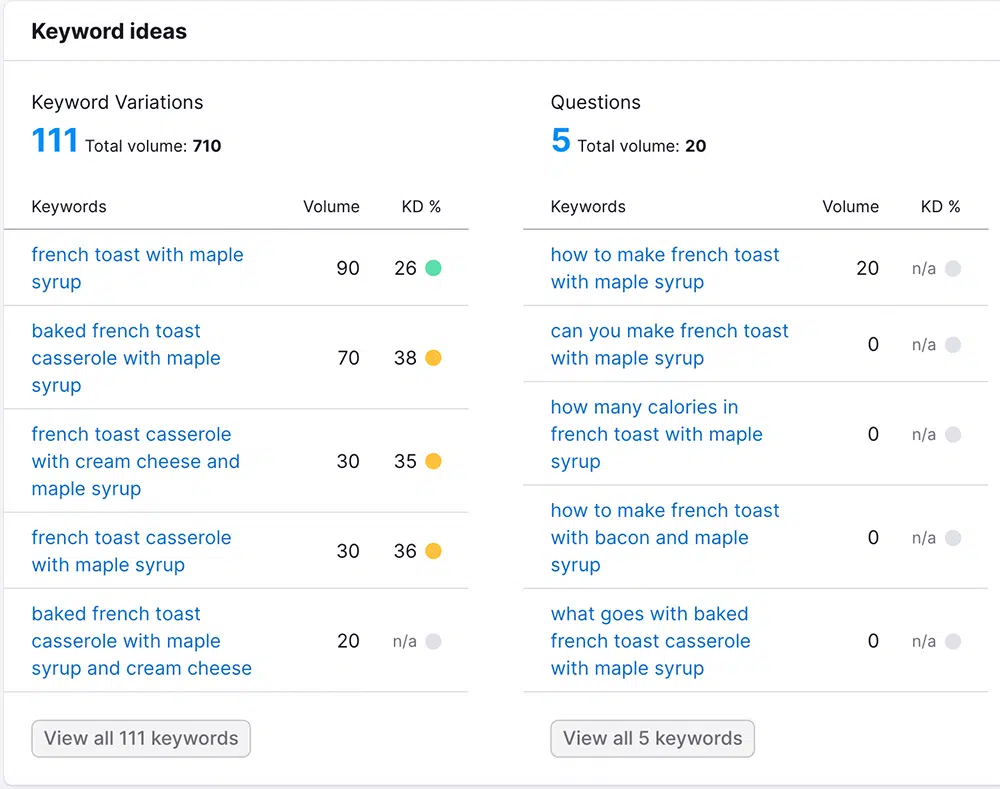
Then, use storytelling in your blog posts to naturally talk about subjects related to your main keyword phrase.
For example, even though our “How to Make the Best French Toast with Maple Syrup” post is about French toast, you could tell related stories that also mention “pancakes” and “waffles.”
You could also write about using maple syrup as an ingredient in baked goods, as a substitute for “sugar” or “honey.”
Step #8: Add Visuals
Text doesn’t have to be the only way for you to communicate with your site visitors. Visuals guide readers through your text and keep readers hooked on your message.
Consider using screenshots, charts, or infographics to enhance your content so it’s not just paragraph after paragraph of straight-up information.
Embedded videos can also help increase the time someone spends on your blog post.
We know that Green Mountain Family Farms will have a budget for professional photography, videography, and design elements that give potential customers a behind-the-scenes look at their maple syrup production.
For the “french toast with maple syrup” blog post, they might even have illustrations that support the comprehension of their recipe.
Make sure to optimize all images added to a blog post by adding:
- Alt text
- Descriptions
- Informative file names
Visuals are an opportunity to rank in Image and Video searches as well.
You’ll want to use a tool like TinyPNG to reduce the size of your files so that they don’t disrupt page-loading time.
Step #9: Link to High-Quality External Resources
Linking to external resources connects your site to the rest of the web.
Plus, you’re not the first person to write about your topic, so it’s smart to show you’ve done your research … and then created an original article that satisfies your target audience.
Referring your readers to other authoritative sources helps build the trustworthiness of your site and also provides them with more details that might go beyond the scope of your article.
If you have more than one website in your niche, linking to relevant articles for more information is a way to expose your different content to new readers.
Blog posts about Organic Maple One-Up have a lot of external linking possibilities, from flour brands that make delicious baked goods to park ranger services that help maintain the forest Green Mountain Family Farms lives and works in.
Step #10: Place Calls-to-Action in Strategic Spots
Identify the main action you’d like a reader to take.
- Sign up for your email list?
- Share a post on social media?
- Schedule a free consultation?
In our “How to Make the Best French Toast with Maple Syrup” post example, the call-to-action typically would be to buy Organic Maple One-Up directly from Green Mountain Farms’ website or to discover where to purchase it at a local store.
The end of your article is the most well-known spot for a call-to-action, but don’t miss opportunities earlier on in your content. As soon as you’ve let readers know how delicious Organic Maple One-Up will be with your French toast recipe, explicitly tell them it’s ready to be purchased.
When your article is unique and interesting, it’s much more shareable … and the more people who share this article with readers who care about the topic, the more people will find out about the benefits of Organic Maple One-Up.
(You might also like our article on the best link building tools to help more people find your content.)
Step #11: Engage Your Audience
Ready for an acronym that sums up all of the steps above?
You guessed it. Enter: FRENCH TOAST.
- Format
- Research
- Easy to read
- Niche
- Competitors
- Headline writing
- Target keywords
- On-page
- Action
- Storytelling
- Transaction
It’s a long acronym, sure, but you can use FRENCH TOAST to make sure you’ve hit all of these engagement elements.
FRENCH TOAST reminds you to identify your ideal reader and craft content specifically for that person.
Once a reader lands on your site, scannable text with intriguing subheadings will help draw them into your words. Subheadings help with engagement because they direct people to the exact part of the article that they need.
Each section of text should make sense on its own and could be thought of as a stand-alone piece of content that provides value, whether or not the reader looks at the rest of the content. But when the section is high-value, your site visitor is more likely to keep reading.
And as they keep reading, they’re one step closer to taking the action you’d like them to take.
Will Generative AI Impact SEO Copywriting?
I’m not going to attempt to make any predictions about the future, but we can look at What Happened in SEO During Q1 2023 for some insights.
And it’s reasonable to ask these questions: Don’t you think SEO copywriting is more relevant than ever in an environment where search is evolving? Don’t you think you need to be a good copywriter, not just someone who creates content?
You have to publish the type of content people want to read and offer an experience that’s more valuable than merely an exchange of information.
SEO copywriting gives your site visitors a reason to both:
- Click through to your site, because it looks like a place they’d like to visit
- Stick around, share your content, and come back, because it’s a publication they like to read
Many writers have already begun incorporating AI copywriting into their process, just as using grammar-checking software became a common practice years ago.
But ultimately, content managers and editors will still need to review a piece of writing for accuracy, relevance, and brand consistency, among other factors.
No one does engagement like humans, and engagement is what SEO copywriting is all about.
Semrush’s Content Marketing Tools can help you immediately get started on the right track to perfectly blend the best SEO practices with your creative ideas.
Click here to check out these Semrush features today.
Semrush
- Semrush – Best overall SEO functionality
- Google Search Console – Best free (partial) data from Google
- Advanced Web Ranking – Best for reporting
- SERPWatcher by Mangools – Best for bloggers and small teams
- Ahrefs – Best for keyword analysis
- SEO PowerSuite – Best affordable option
- SEO Monitor – Best for forecasting
- Local Viking – Best for local SEO map tracking
- Nozzle – Best for data visualization
- ProRankTracker – Best for agencies and SEO professionals